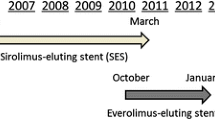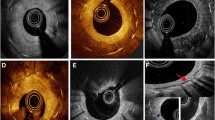Abstract
This study was designed to compare neointimal hyperplasia and peri-stent arterial remodeling after implantation of everolimus-eluting stent (EES) versus sirolimus-eluting stent (SES) using intravascular ultrasound (IVUS). The study population was a subgroup of 278 patients from the EXCELLENT trial, a randomized study comparing EES to SES in de novo coronary artery lesions (total n = 1,443, 3:1 randomization) who underwent post-PCI and 9-month follow-up IVUS evaluation. There were 209 patients in the EES group and 69 in the SES group. Baseline clinical and angiographic characteristics were similar between the two groups except for age and target lesion locations. At 9 months, percent neointimal volume obstruction did not differ between EES and SES (2.6 ± 4.0 % vs. 2.5 ± 4.8 %, p = 0.814). However, the relative change in the vessel (4.3 ± 13.7 % vs. 8.8 ± 18.6 %, p = 0.030) and plaque volume index (4.2 ± 17.4 % vs. 10.5 ± 22.3 %, p = 0.016) of the stented segment from post-intervention to follow-up was significantly less with EES than with SES. In addition, positive peri-stent vascular remodeling defined as an increase in vessel volume index >10 % (27.8 vs. 42.0 %, p = 0.027) and late acquired stent malapposition (LASM, 1.9 vs. 15.9 %, p < 0.001) were observed less frequently with EES than SES. EES and SES were similarly effective in reducing neointimal hyperplasia. However, positive peri-stent vascular remodeling and LASM occurred less frequently with EES than SES.

Similar content being viewed by others
References
Costa RA, Lansky AJ, Mintz GS et al (2005) Angiographic results of the first human experience with everolimus-eluting stents for the treatment of coronary lesions (the FUTURE I trial). Am J Cardiol 95:113–116
Serruys PW, Ong AT, Piek JJ et al (2005) A randomized comparison of a durable polymer Everolimus-eluting stent with a bare metal coronary stent: the SPIRIT first trial. EuroIntervention 1:58–65
Applegate RJ, Yaqub M, Hermiller JB et al (2011) Long-term (three-year) safety and efficacy of everolimus-eluting stents compared to paclitaxel-eluting stents (from the SPIRIT III Trial). Am J Cardiol 107:833–840
Park KW, Yoon JH, Kim JS et al (2009) Efficacy of Xience/promus versus Cypher in rEducing Late Loss after stENTing (EXCELLENT) trial: study design and rationale of a Korean multicenter prospective randomized trial. Am Heart J 157(811–817):e811
Park KW, Chae IH, Lim DS et al (2011) Everolimus-eluting versus sirolimus-eluting stents in patients undergoing percutaneous coronary intervention the EXCELLENT (Efficacy of Xience/Promus Versus Cypher to Reduce Late Loss After Stenting) Randomized Trial. J Am Coll Cardiol 58:1844–1854
Moses JW, Leon MB, Popma JJ et al (2003) Sirolimus-eluting stents versus standard stents in patients with stenosis in a native coronary artery. N E J Med 349:1315–1323
Schomig A, Dibra A, Windecker S et al (2007) A meta-analysis of 16 randomized trials of sirolimus-eluting stents versus paclitaxel-eluting stents in patients with coronary artery disease. J Am Coll Cardiol 50:1373–1380
Park DW, Kim YH, Yun SC et al (2010) Comparison of zotarolimus-eluting stents with sirolimus- and paclitaxel-eluting stents for coronary revascularization: the ZEST (comparison of the efficacy and safety of zotarolimus-eluting stent with sirolimus-eluting and paclitaxel-eluting stent for coronary lesions) randomized trial. J Am Coll Cardiol 56:1187–1195
Rasmussen K, Maeng M, Kaltoft A et al (2010) Efficacy and safety of zotarolimus-eluting and sirolimus-eluting coronary stents in routine clinical care (SORT OUT III): a randomised controlled superiority trial. Lancet 375:1090–1099
Mintz GS, Nissen SE, Anderson WD et al (2001) American College of cardiology clinical expert consensus document on standards for acquisition, measurement and reporting of intravascular ultrasound studies (IVUS). A report of the American College of cardiology task force on clinical expert consensus documents. J Am Coll Cardiol 37:1478–1492
Hong MK, Mintz GS, Lee CW et al (2006) Late stent malapposition after drug-eluting stent implantation: an intravascular ultrasound analysis with long-term follow-up. Circulation 113:414–419
Hong MK, Mintz GS, Lee CW et al (2004) Incidence, mechanism, predictors, and long-term prognosis of late stent malapposition after bare-metal stent implantation. Circulation 109:881–886
Stone GW, Midei M, Newman W et al (2008) Comparison of an everolimus-eluting stent and a paclitaxel-eluting stent in patients with coronary artery disease: a randomized trial. JAMA 299:1903–1913
de Waha A, Dibra A, Byrne RA et al (2011) Everolimus-eluting versus sirolimus-eluting stents: a meta-analysis of randomized trials. Circ Cardiovasc Interv 4:371–377
Kaiser C, Galatius S, Erne P et al (2010) Drug-eluting versus bare-metal stents in large coronary arteries. N E J Med 363:2310–2319
Kim WJ, Lee SW, Park SW et al (2011) Randomized comparison of everolimus-eluting stent versus sirolimus-eluting stent implantation for de novo coronary artery disease in patients with diabetes mellitus (ESSENCE-DIABETES): results from the ESSENCE-DIABETES trial. Circulation 124:886–892
Byrne RA, Kastrati A, Massberg S et al (2011) Biodegradable polymer versus permanent polymer drug-eluting stents and everolimus- versus sirolimus-eluting stents in patients with coronary artery disease: 3-year outcomes from a randomized clinical trial. J Am Coll Cardiol 58:1325–1331
Okkels Jensen L, Thayssen P, Hansen HS et al (2012) Randomized comparison of everolimus-eluting and sirolimus-eluting stents in patients treated with percutaneous coronary intervention: the Scandinavian organization for randomized trials with clinical outcome IV (SORT OUT IV). Circulation 125:1246–1255
Guo N, Maehara A, Mintz GS et al (2010) Incidence, mechanisms, predictors, and clinical impact of acute and late stent malapposition after primary intervention in patients with acute myocardial infarction: an intravascular ultrasound substudy of the Harmonizing Outcomes with Revascularization and Stents in Acute Myocardial Infarction (HORIZONS-AMI) trial. Circulation 122:1077–1084
Nakazawa G, Finn A, John M, Kolodgie F, Virmani R (2007) The significance of preclinical evaluation of sirolimus-, paclitaxel-, and zotarolimus-eluting stents. Am J Cardiol 100:S36–S44
Miyazawa A, Ako J, Hongo Y et al (2008) Comparison of vascular response to zotarolimus-eluting stent versus sirolimus-eluting stent: intravascular ultrasound results from ENDEAVOR III. Am Heart J 155:108–113
Sakurai R, Bonneau HN, Honda Y, Fitzgerald PJ (2007) Intravascular ultrasound findings in ENDEAVOR II and ENDEAVOR III. Am J Cardiol 100:71M–76M
Rathore S, Terashima M, Habara M et al (2009) Incomplete stent apposition after coronary stent implantation: myth or reality? J Interv Cardiol 22:341–349
Hassan AK, Bergheanu SC, Stijnen T et al (2010) Late stent malapposition risk is higher after drug-eluting stent compared with bare-metal stent implantation and associates with late stent thrombosis. Eur Heart J 31:1172–1180
Cook S, Wenaweser P, Togni M et al (2007) Incomplete stent apposition and very late stent thrombosis after drug-eluting stent implantation. Circulation 115:2426–2434
Nakazawa G, Finn AV, Vorpahl M, Ladich ER, Kolodgie FD, Virmani R (2011) Coronary responses and differential mechanisms of late stent thrombosis attributed to first-generation sirolimus- and paclitaxel-eluting stents. J Am Coll Cardiol 57:390–398
Iakovou I, Schmidt T, Bonizzoni E et al (2005) Incidence, predictors, and outcome of thrombosis after successful implantation of drug-eluting stents. JAMA 293:2126–2130
Hasebe T, Shimada A, Suzuki T et al (2006) Fluorinated diamond-like carbon as antithrombogenic coating for blood-contacting devices. J Biomed Mater Res, Part A 76:86–94
Briguori C, Sarais C, Pagnotta P et al (2002) In-stent restenosis in small coronary arteries: impact of strut thickness. J Am Coll Cardiol 40:403–409
Kastrati A, Mehilli J, Dirschinger J et al (2001) Intracoronary stenting and angiographic results: strut thickness effect on restenosis outcome (ISAR-STEREO) trial. Circulation 103:2816–2821
Baber U, Mehran R, Sharma SK et al (2011) Impact of the everolimus-eluting stent on stent thrombosis: a meta-analysis of 13 randomized trials. J Am Coll Cardiol 58:1569–1577
Acknowledgments
This study was partly supported by a grant from the Korea Healthcare Technology R&D Project, Ministry for Health, Welfare & Family Affairs, Republic of Korea (No. A085012, A102064, and A110879); a grant from the Korea Health 21 R&D Project, Ministry of Health & Welfare, Republic of Korea (No. A085136); and the Cardiovascular Research Center, Seoul, Korea.
Conflict of interest
The authors also received research grants from Abbott Vascular Korea and Boston Scientific Korea. The funding sources of the study had no role in study design, data collection, monitoring, analysis, interpretation, or writing of the manuscript.
Author information
Authors and Affiliations
Consortia
Corresponding author
Rights and permissions
About this article
Cite this article
Ko, YG., Shin, DH., Kim, JS. et al. Comparison of neointimal hyperplasia and peri-stent vascular remodeling after implantation of everolimus-eluting versus sirolimus-eluting stents: intravascular ultrasound results from the EXCELLENT study. Int J Cardiovasc Imaging 29, 1229–1236 (2013). https://doi.org/10.1007/s10554-013-0199-5
Received:
Accepted:
Published:
Issue Date:
DOI: https://doi.org/10.1007/s10554-013-0199-5




